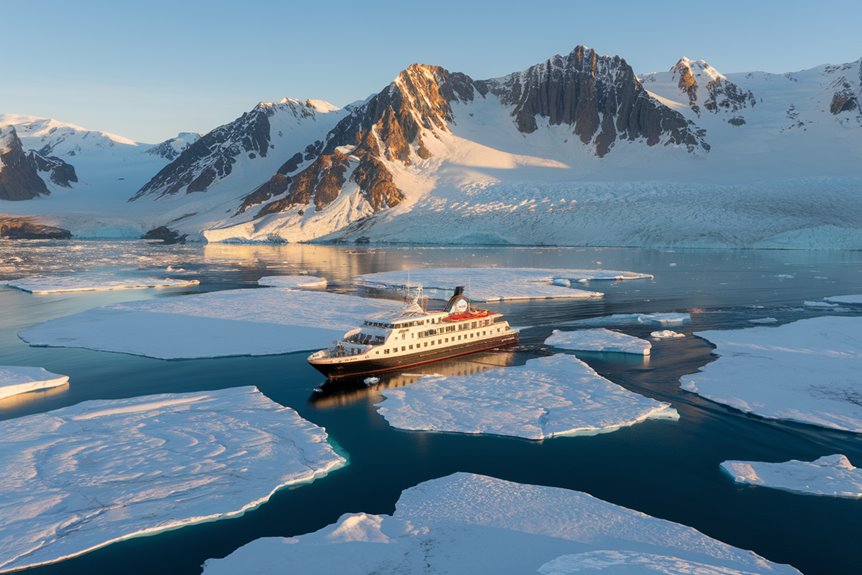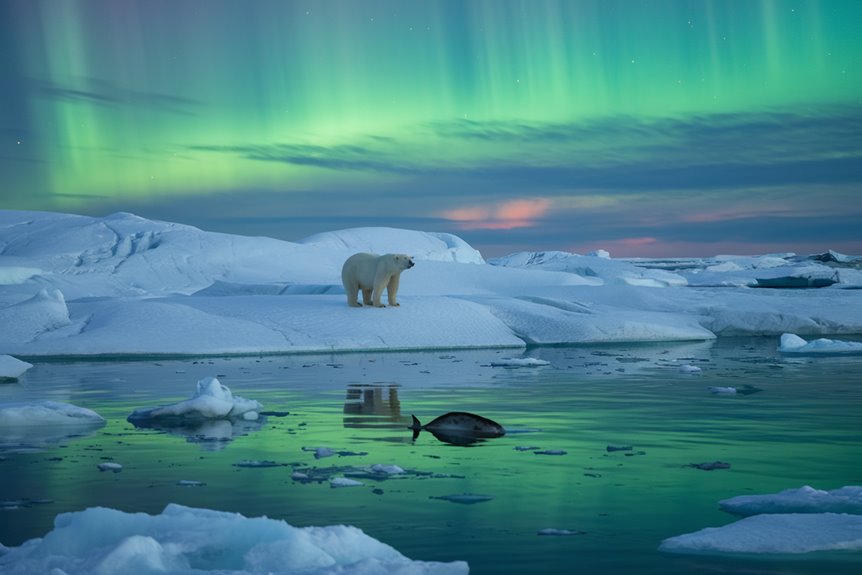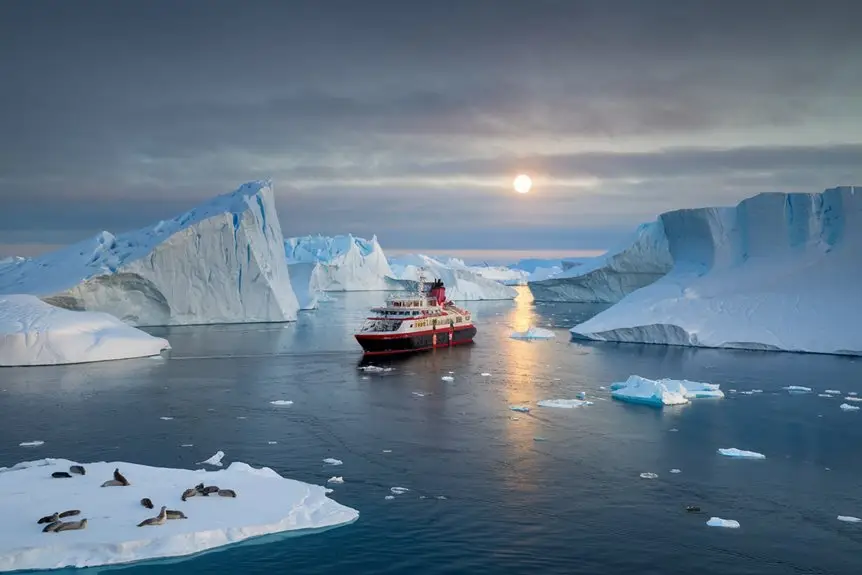You can explore Arctic Canada on expedition cruises from June to September, travelling through one of Earth’s most untouched regions. Your journey takes you through clear Arctic waters where you’ll spot polar bears, narwhals and Arctic foxes in their home environment.
For other Arctic Cruise Destinations check out our Arctic Cruise Destinations Guide page.
These ships provide cosy cabins and guided trips, letting you reach hidden spots by Zodiac boat. You’ll connect with Inuit communities, watch traditional shows and discover ancient settlements during your voyage.
Choose July or August for round-the-clock daylight and the best wildlife spotting. September offers you chances to see the Northern Lights dancing across the sky.
Your expedition ship comes equipped with modern comforts whilst expert guides help you understand this unique polar environment. The Arctic’s raw beauty and rich culture will give you a new perspective on this remarkable part of our planet.
🐧 Polar Cruise Enquiry 🐻❄️
Our team of polar travel specialists have personally explored both the Arctic and Antarctic regions – from tracking polar bears in Svalbard to kayaking with penguins off the Antarctic Peninsula. Let us find the right polar expedition cruise for you.
Key Takeaways
- You’ll find Arctic Canada cruises running from June to September, with the best wildlife spotting in July and August.
- Your vessel options include basic expedition ships or luxury cruisers, each offering different comfort levels – from practical to plush.
- The Northwest Passage forms a key route where you’ll discover historic landmarks, meet Inuit communities and spot Arctic wildlife.
- You can join daily Zodiac boat trips, watch for wildlife, visit local Inuit settlements and learn from Arctic experts on guided tours.
- You’ll spot impressive Arctic animals in their natural homes, including polar bears hunting on ice floes, narwhals and belugas swimming nearby, and countless seabirds soaring overhead.
Planning Your Arctic Adventure

You’ll need a full year to plan your Arctic Canada cruise properly. The most popular sailing times are:
- June to August: experience midnight sun and warmer weather
- September: watch the northern lights
Your key planning steps:
- Choose your vessel type:
- Expedition ships: more adventurous, basic amenities
- Luxury ships: higher comfort, more facilities
- Check your fitness level:
- Arctic trips require good physical condition
- You’ll face challenging weather and terrain
- Sort your essentials:
- Book comprehensive travel insurance
- Reserve your flights
- Plan your excursions
- Calculate crew gratuities
- Consider pre/post-cruise stays
- Set your budget for:
- Main cruise fare
- All travel costs
- Optional activities
- Extra accommodation
This straightforward approach will help you organise your Arctic adventure efficiently.
Wildlife and Natural Wonders

Experience the Arctic’s incredible wildlife, perfectly suited to survive in extreme conditions.
You’ll see polar bears hunting near Churchill, muskoxen displaying their thick winter coats, and arctic foxes switching their fur colours with changing seasons.
Your Arctic expedition lets you watch:
- Beluga whales swimming in Cunningham Inlet’s summer waters
- Arctic terns and guillemots nesting in coastal colonies
- Walruses resting on floating ice near the shore
- Migratory birds raising their young in Arctic wetlands
- You can spot ringed and bearded seals as they hunt for arctic cod.
- In deeper waters, you’ll find narwhals showing off their unique tusks.
Your cruise gives you the best spots to see these amazing animals in their natural home.
Life Aboard An Expedition Cruise Ship

Life aboard an Arctic cruise ship offers you both adventure and comfort in equal measure. Your cabin should provide modern amenities and plenty of space to relax. You can enjoy diverse meals in the ships restaurant, and unwind in the heated saltwater pool, hot tub or sauna.
Your daily schedule starts with clear briefings from your expedition team. You then join guided Zodiac trips with expert crews, including armed guards who keep watch for polar bears.
You’ll meet specialists who share their knowledge and learn directly from Inuit teachers in hands-on workshops.
The ship keeps you safe with its medical centre, secure lifeboats and well-practised safety plans. Your guides know the Arctic waters intimately and work alongside local experts to give you the best experience.
Evening activities include wildlife talks and social events to help you connect with fellow travellers.
See what’s on offer from the Greenland Expedition Cruise Routes for a different Arctic Cruise destination.
Best Time to Cruise

You’ll find the perfect Arctic Canada cruising conditions during July and August. These summer months offer warm temperatures and excellent wildlife sightings.
Choose your cruise timing based on these clear benefits:
- July-August
- You can spot polar bears, walruses and whales
- You’ll experience the warmest temperatures
- You’ll enjoy 24-hour daylight
- September
- You can watch migrating whales
- You’ll see the Northern Lights begin
- You’ll encounter fewer tourists
- Late Summer Benefits
- You can access more remote locations
- You’ll navigate through ice-free waters
- You’ll enjoy stable weather patterns
- Northwest Passage (Mid-August to September)
- You can sail through open channels
- You’ll follow historic expedition routes
- You’ll meet local communities
Winter cruises stop completely due to ice and harsh weather.
Spring brings stunning icebergs, but you’ll face colder temperatures.
Cultural and Historical Sites

Arctic Canada’s cultural and historical sites connect you to Inuit heritage and polar exploration stories.
You can visit the Franklin Expedition graves on Beechey Island and sail through the Northwest Passage’s historic waters. Kinngait welcomes you to watch local artists create traditional Inuit carvings in their workshops.
You’ll meet friendly Inuit communities who share their culture through drum dancing, storytelling and games. Local guides teach you traditional skills, and you can taste authentic Arctic foods.
Ancient Thule settlements and historic markers dot the Nunavik Coast and Baffin Island, showing you different periods of Arctic life.
You’ll discover how past meets present at key cultural spots like Tallurutiup Imanga and Ungava Bay.
Frequently Asked Questions
What Happens if a Medical Emergency Occurs During the Remote Arctic Cruise?
In a medical emergency during your Arctic cruise, the onboard medical team will respond immediately. You have access to a fully equipped ship’s infirmary with qualified doctors. The medical staff can treat common illnesses and stabilise serious conditions. If you need advanced care, the ship’s crew will arrange your evacuation to the nearest suitable hospital. The ship maintains constant communication with emergency services and medical facilities on land to support your care.
Can Children Participate in Arctic Expedition Cruises?
You can take your children on Arctic expedition cruises with some important guidelines. Your kids must be at least 5 years old to join Zodiac boat trips and outdoor activities. They’ll need to understand and follow basic safety rules during the voyage. You’ll find most cruise operators welcome families whilst maintaining strict safety standards for everyone’s protection.
Are Special Cameras or Photography Equipment Needed for Arctic Conditions?
Arctic photography requires specific gear to handle extreme conditions. Keep your equipment simple and reliable:
Your essential kit includes:
- A cold-weather resistant camera body
- A backup camera body
- Extra batteries (cold drains them quickly)
- Waterproof camera cases
- All-purpose zoom lenses
You should store your batteries close to your body for warmth and pack your gear in sealed bags to prevent condensation. When you move between warm and cold environments, let your equipment adjust gradually to avoid moisture damage.
These items will help you capture the Arctic’s dramatic landscapes whilst protecting your valuable photography equipment.
How Reliable Is Internet and Phone Connectivity During Arctic Voyages?
Internet and phone connectivity in the Arctic varies significantly based on your location. You’ll experience limited connectivity during most of your voyage, with service becoming increasingly unreliable as you travel northward. Your mobile phone will likely lose signal beyond coastal areas, whilst satellite internet offers intermittent access. Starlink services have improved connectivity options, but you should still expect regular disruptions. You’ll find the most reliable connections near populated coastal settlements. Plan your communication needs around these limitations by downloading essential content beforehand and informing your contacts about potential delays in responses.
Do Passengers Need Specific Vaccinations or Medical Clearance Before Arctic Cruising?
Before your Arctic cruise, you need:
- A medical clearance document from your doctor
- A completed health declaration form
- Medical evacuation insurance coverage
Recommended vaccinations:
- COVID-19 vaccine
- Seasonal flu jab
While no specific vaccinations are legally required, staying up-to-date with these immunisations helps protect you and fellow passengers during your Arctic journey.
Thinking about something different? Check out the Iceland Circumnavigation Cruise Guide.
🐧 Polar Cruise Enquiry 🐻❄️
Our team of polar travel specialists have personally explored both the Arctic and Antarctic regions – from tracking polar bears in Svalbard to kayaking with penguins off the Antarctic Peninsula. Let us find the right polar expedition cruise for you.
